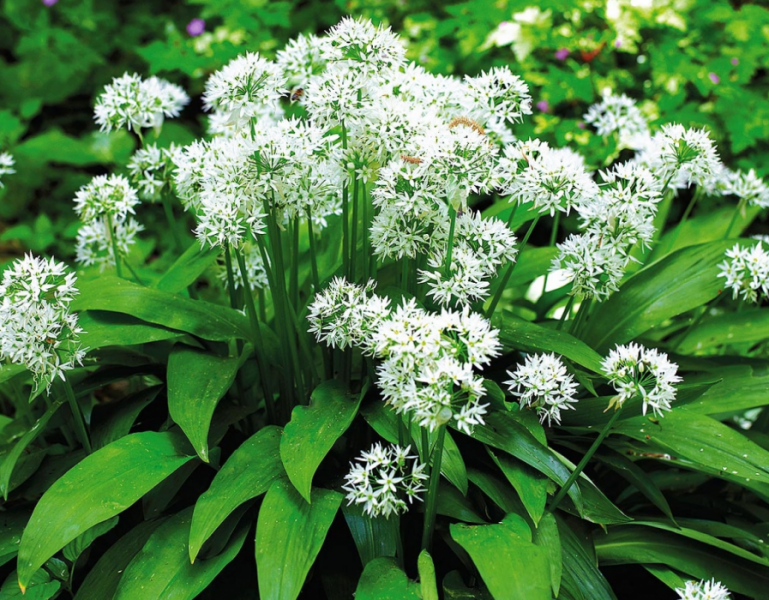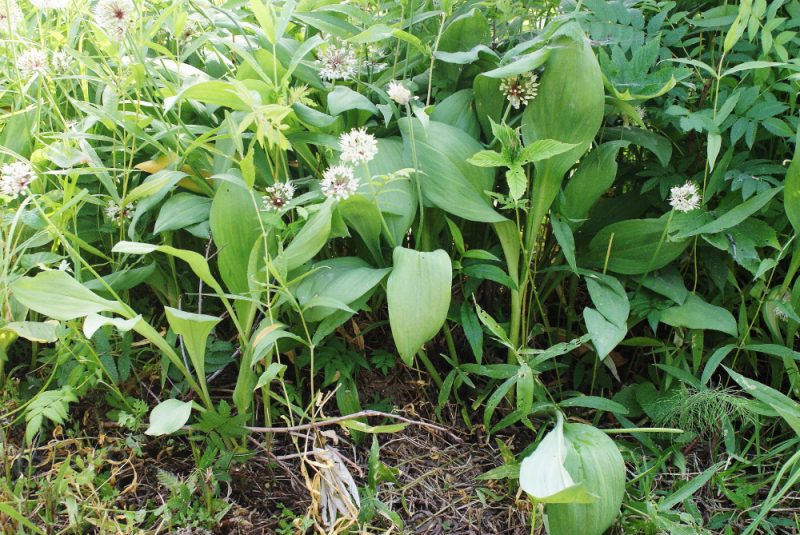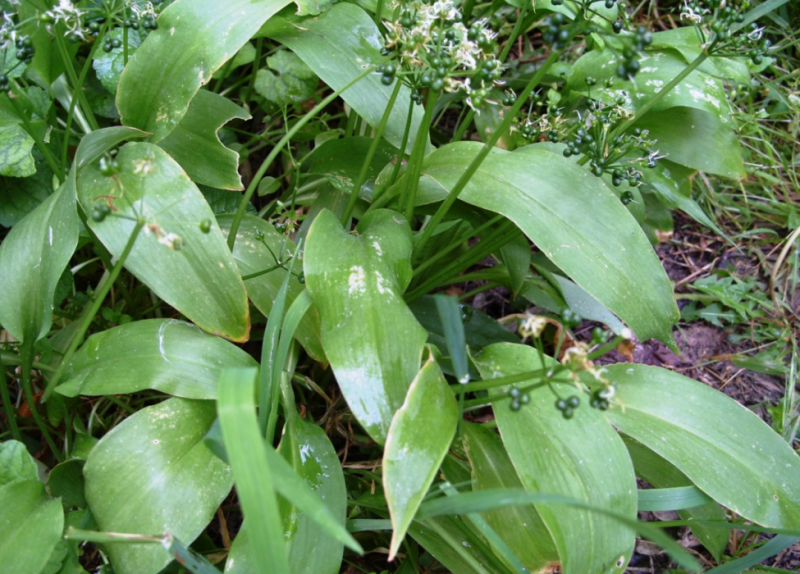Home-grown wild garlic from seeds or bulbs is a great way to get tasty and healthy greens. The plant is happy with the harvest annually. And the collection is carried out in early spring, when the human body especially needs vitamins.
Material Content:
What is wild garlic
Ramson (bear bow) - herbaceous perennial from Amaryllis. In the wild, it is found in a wooded area or near rivers in many countries of Europe, in Turkey and the Caucasus. Wild garlic starts growing as soon as the snow melts and the soil warms up a bit. Her young leaves are happy to eat bears, because this is one of the earliest sources of vitamins in the forest.
The height of an adult plant is up to 50 cm. It has a rhizome with a bulb and a narrow stem in the shape of a trihedron. Elongated leaves up to 5 cm wide resemble lily of the valley in appearance. They have a specific garlic-onion smell and taste, therefore wild garlic is also called wild garlic. Umbrella inflorescences with white flowers appear in late spring or early summer. Fruits of spherical shape ripen in June or July, the foliage gradually dies by this time.
In several regions of Russia, Ukraine, Belarus and some Baltic countries, perennial is listed in the Red Book.
Wild wild garlic is becoming less and less due to deforestation, adverse environmental conditions and uncontrolled gathering by people. A plant torn from the roots is not restored.
Useful properties of wild garlic:
- will help get rid of vitamin deficiency, because 50 grams of the product contains the daily intake of vitamin C;
- used for colds and inflammatory processes of the genitourinary system;
- It is used to treat gastrointestinal diseases.
Due to its many advantages, perennials are increasingly grown as a cultivated plant. Not only young leaves are consumed, but also shoots, bulbs of wild garlic. It is appropriate to freeze, add to pickles and marinades. It is not recommended to include wild garlic in the diet of livestock. After using the product, the milk acquires a yellowish-red color. The taste of meat in animals that are regularly fed wild garlic is reduced.
The nuances of growing from seeds
At home, you can use one of two ways to grow new wild garlic specimens:
- Sow the seeds.
- Seedling young bulbs.
The seed method will allow you to get many plants at once, but it has several disadvantages:
- seeds lose their germination very quickly;
- young shoots will appear soon, 1-1.5 years after sowing;
- the first crop is harvested only for 3-4 years after planting the seeds in the ground.
Planting material can be obtained from home mother liquors or purchased in specialized stores. When buying, study the shelf life of the products. The fresher the seeds, the more likely to wait for seedlings. Choose a product in black, round shape. It is better to refuse to buy shriveled, grayish seeds.
At home, ramson fruits ripen in the summer or early fall. Yellowed boxes are cut, the seeds are poured out and dried. It is best to plant them immediately after they have sung. If this is not possible, you can postpone the work in the spring.
Typically, wild garlic sowing is carried out from the first decade of September to mid-October. Timing shifts depending on weather conditions and the region of cultivation.
The optimum outdoor temperature during the period of work is about +20 ° C. If the temperature indicators at this time are lower than +10 ° C or higher than +25 ° C, then seed germination is significantly reduced. It is advisable to use fresh planting material of the current year, and before embedding it into the ground it is appropriate to sprout.
How to do it:
- Soak the seeds in a growth stimulator for about 4-5 hours (if desired). For example, you can use "Epin", "Zircon", "Kornevin."
- Moisten a piece of cloth with water, place seed material on a damp surface.
- Roll up the material and place in a small container.
- Cover with paper or a piece of cloth. So fresh air will enter the tank, and the evaporation of moisture will decrease.
It is important that the fabric stays wet at all times. In addition, they withstand temperatures from + 19 ° C to + 22 ° C. Seeds sprout worse in a cool or hot room. They will not hatch at all if the temperature in the room is constantly less than + 10 ° C or higher + 26 ° C. For germination, the seeds will need from 20 to 30 days. They are transferred to the ground until mid or late October, depending on the weather.
Sprouted seeds must be planted immediately. They are very small, easily washed out of the ground during melting snow and rains. They are easier to preserve if first sown in special nurseries - small containers with drainage holes. The prepared containers are filled with a mixture of peat, leaf soil and compost in a ratio of 1: 2: 1. Do not use coniferous sod. After preparing the soil, the seed material is sealed to a depth of about 1 cm, a distance of 0.5 cm is maintained between adjacent specimens. The containers are transferred to open ground and added dropwise in a shaded place. A layer of mulch of humus and sand (1 cm) is placed on the surface, and a layer of leaves about 4 cm high is placed on top. The crops are moisturized and the soil does not dry out. Shoots will appear in about a year.
Seeds can be sown not only in autumn but also in spring. In this case, they need preliminary stratification. Before sowing, the seed material is kept for at least 2.5-3 months in a refrigerator at a temperature of 0 ° C to +3 ° C.
In spring, mulch on young landings is partially removed.Gentle sprouts are constantly watered. If necessary, resume the mulching layer of soil and sand. Young plants are transplanted into the open soil a year later. Dig them out with care so as not to damage the root system.
Landing at home and in the garden
In one place, wild leeks have been cultivated for many years, so the place for planting is chosen carefully. An area without bright sun where water does not stagnate is suitable. In nature, wild garlic feels good in partial shade, so it is appropriate to plant it near the fence, under trees or between bushes.
A plant will appreciate land with a high organic content and low acidity. The soil should be light, well-drained. To reduce acidity, you can liming, add wood ash or chopped eggshells to the ground.
The site is pre-excavated, leveled, weeds are removed. 2-3 weeks before planting wild garlic make rotted organic matter, such as humus or compost. If necessary, nitrogen (up to 20 g per square meter), potash (up to 15 g per square meter) and phosphorus (up to 30 g per square meter) fertilizers are added to the soil.
For reproduction take only bulbs on which there are roots. If the root system is weak or dry, then the plants take root much worse.
Landing in the open ground can be carried out in autumn or spring. At the beginning of the growing season, work is carried out in April or May, and at the end of the season, from August to October.
It is best to place the heads in the soil in the fall when the plant is already resting. The distance between adjacent specimens is at least 20 cm, the row spacing is about 45 cm. The bulbs must be deepened by 2/3, sprinkled with earth and well moistened. It is appropriate to mulch the plantings first with peat for a couple of centimeters, and on top with a layer of fallen leaves 6-8 cm high. If autumn is dry, additional watering may be necessary before the start of winter.
Features of reproduction and care
How to care for a bear bow:
- Plants are regularly moderately watered. After drying of the surface part of the humidification is not carried out, enough natural precipitation.
- The soil is loosened shallow so as not to damage the sensitive bulbs.
- Timely weeds are removed between rows.
- On the site, the soil must be mulched so that it does not dry out.
- At the beginning of the growing season, it is appropriate to feed wild garlic with organic fertilizers. For example, fermented infusions of cow manure, bird droppings or nettles.
On the shoot of wild garlic, only one additional bulb is formed each year, so it vegetatively propagates rather slowly. The place of growing for a bear onion is changed approximately 6-7 years after laying the beds. The plants themselves will tell you that it is time to transplant them: the leaves and stems are smaller, the heads multiply worse. Over time, the bulbs go deep into the ground.
Ramson often propagates by self-sowing. In this case, the plantings are too thick, the young shoots need to be planted from time to time. Bear onions are not afraid of return frosts, therefore, leaf mulch is removed in early spring, leaving only a layer with a height of no more than 2-3 cm.
Protection against diseases and pests
Parasites rarely bother wild garlic, as it contains a lot of essential oils, has a specific taste and aroma. A plant may be affected by the activity of larvae of a mining fly. They settle inside the leaves and eat up lush vegetation. On the wild garlic, small convex sections of a semicircular shape with a diameter of about 1 mm and a length of up to 1 cm appear. The leaf blades brighten, dry out and die over time. To control larvae, insecticides are used, observing safety rules and the waiting period after their application.
With excessive watering, rotting of the bulbs is observed. Fluffy coating may appear on leaves and stems. Damaged rot plants are removed. To avoid problems, it is necessary to adjust the amount of humidification depending on weather conditions.
Rust is a fungal disease that causes the appearance of red areas on the front side of leaf plates and plaque on the inside. Over time, the spots become brown. To prevent rust, carbamide solution is sprayed in early spring. And after harvesting - with a solution of copper sulfate. At the first signs of the disease, a fungicide is used, for example, Bayleton or Topaz.
Gardener tips
Secrets of wise experience of ramson lovers:
- The first two springs do not cut the leaves so that the planted young plant grows stronger. Harvest begins to be harvested only for the third season of vegetation. And peduncles on young specimens are removed so that the bulbs are stronger.
- The most delicious leaves that are grown at temperatures from +12 ° C to +17 ° C. If it has warmed up to +20 ° C and above, then the quality of the products worsens, especially in dry weather.
- When harvesting, they must leave 1-2 leaves on the plant so that the wild garlic recovers without problems.
You can get wild garlic vitamin in winter. For this, plants must be transplanted at the end of October into suitable pots. Use a narrow container with a depth of at least 30 cm. Containers with wild garlic are transferred to the house and placed on the windowsill. Regularly watered, and in January, a crop of young leaves is harvested.
In the wild, wild garlic is getting smaller. Experienced gardeners recommend growing a perennial as a cultivated plant in order to provide themselves with early vitamin products.















